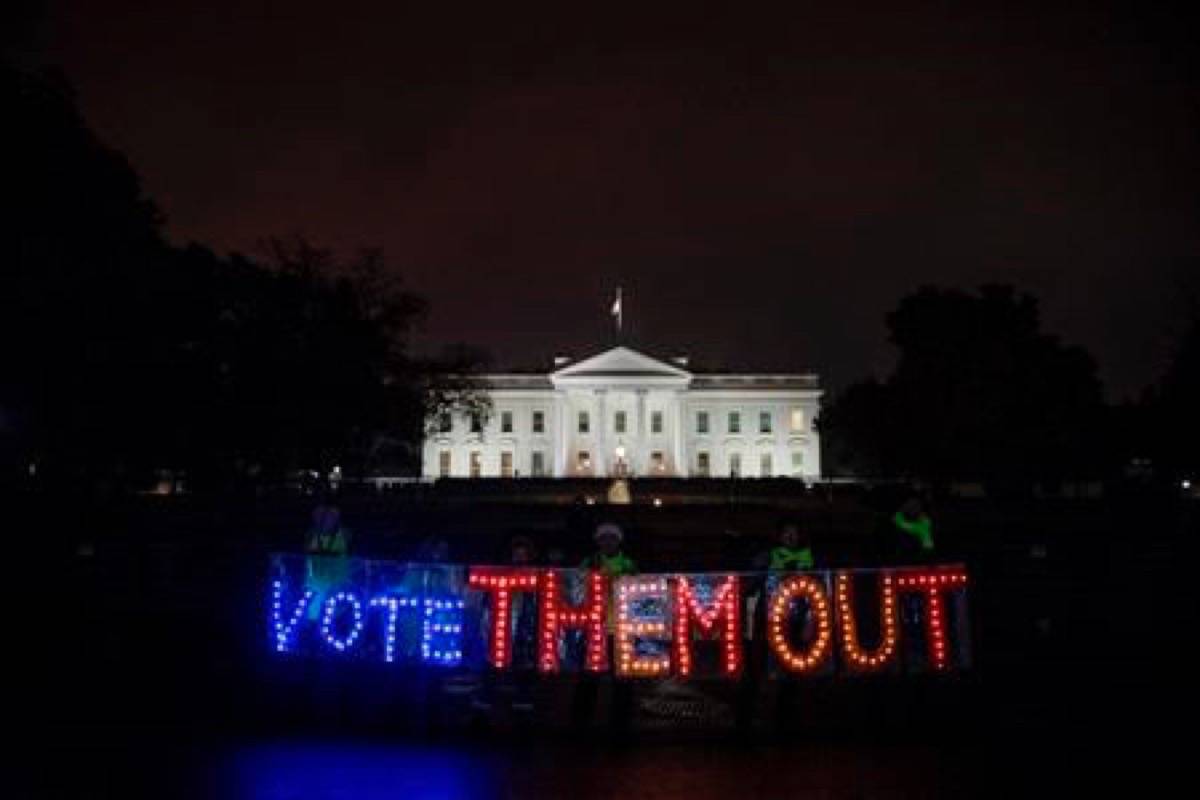No one knows yet if it will be red, blue or purple, but a tidal wave of energized voters is flooding polling stations across the United States as Americans seek to deliver their early verdict on President Donald Trump.
Unlike past midterm votes, which are known for the faint public attention they get, the 2018 edition has generated robust early voting turnout — in Arizona, Nevada, Texas and Utah, the number of advance ballots exceeded the total cast in 2014.
There were reports of long lineups throughout the morning in New Hampshire, Georgia and Texas, while other districts reported unprecedented levels of voter interest throughout the morning. Democratic Party campaign workers at one northern Virginia location cited a 63-per-cent spike in interest over previous years.
“Typically, independents and younger voters tend to turn out less in these off-term, midterm congressional years,” said Carleton University politics professor Melissa Haussman. “This particular year is an exception because of the anti-Trump feeling on the part of a lot of them.”
There are too many fundamental differences between electoral systems and cycles in the U.S. and Canada for this year’s stateside turnout to offer any lessons for anyone hoping to generate similar levels of interest north of the border in 2019, Haussman said.
READ MORE: All-consuming midterm battles heat up as US campaigns near the end
READ MORE: On eve of U.S. midterms, not all women are mobilized against Trump
Turnout, she said, has everything to do with a campaign’s most prominent figures and whether voters who aren’t regular participants in the electoral process are more motivated to take part.
More than 68 per cent of registered voters in Canada turned out in the last federal election in 2015, when Justin Trudeau’s youthful, social-media-savvy campaign and promised re-engagement with Indigenous communities helped to mobilize young and disenfranchised voters — the strongest turnout since 1993. That year, turnout in Canada exceeded 69 per cent.
In both cases, voters turned up to turf out long-standing Conservative governments: Stephen Harper in 2015 and Kim Campbell, who took over briefly for Brian Mulroney, 22 years earlier.
Given the prominent roles figures like Trump and former presidents Barack Obama and Bill Clinton have played in the midterm campaign, maybe there’s a lesson for past prime ministers, Haussman suggested.
“We’ve seen former presidents go around campaigning, and perhaps Canada could also invoke former prime ministers to do a little more campaigning on both sides,” she said. ”Depending on who’s in power in Canada, former prime ministers might want to get involved a bit.”
In the United States, during what’s been one of the most remarkable political seasons in the country’s modern history, some experts are wondering if the country is in the midst of a historic partisan realignment, one that could have lasting consequences for the traditional red-blue model.
“Things are pretty good, yet we have all this division and we have this president who’s relatively unpopular, so we have this strange juxtaposition,” said Kent State politics professor Michael Ensley, citing Trump’s poor approval ratings despite a rollicking U.S. economy and the absence of major foreign-policy challenges.
Presidential tides are supposed to rise and fall with traditional economic indicators like job creation, wage rates, unemployment and consumer confidence — all of which are going gangbusters, according to numbers released last week. Yet for Trump, talking about the economy just isn’t very exciting, he admitted on the weekend.
“The broad question I keep asking myself is, are we at a point of a fundamental change in the American party system?” Ensley said. “I’m torn on the answer to that question.”
Democrats, sensing an opportunity to regain control of the House of Representatives, have been pounding the health-care drum, promising to defend insurance coverage for pre-existing health conditions from what they predict will be a renewed Republican assault on the Affordable Care Act.
But where the Republicans should be touting an economy firing on all cylinders, Trump has been sticking to his 2016 playbook, rallying his red-hatted supporters by raging against a South American migrant “caravan” slowly making its way through Mexico.
“Democrats are inviting caravan after caravan of illegal aliens to flood into our country and overwhelm your communities,” he told a Make America Great Again rally Monday in the swing state of Ohio.
Before he left Washington, the president appeared to hedge his bets against a Democratic breakthrough, tweeting an ominous warning to anyone engaged in what he called “illegal voting” that they would be subject to the “maximum criminal penalties” the law allows.
James McCarten, The Canadian Press



